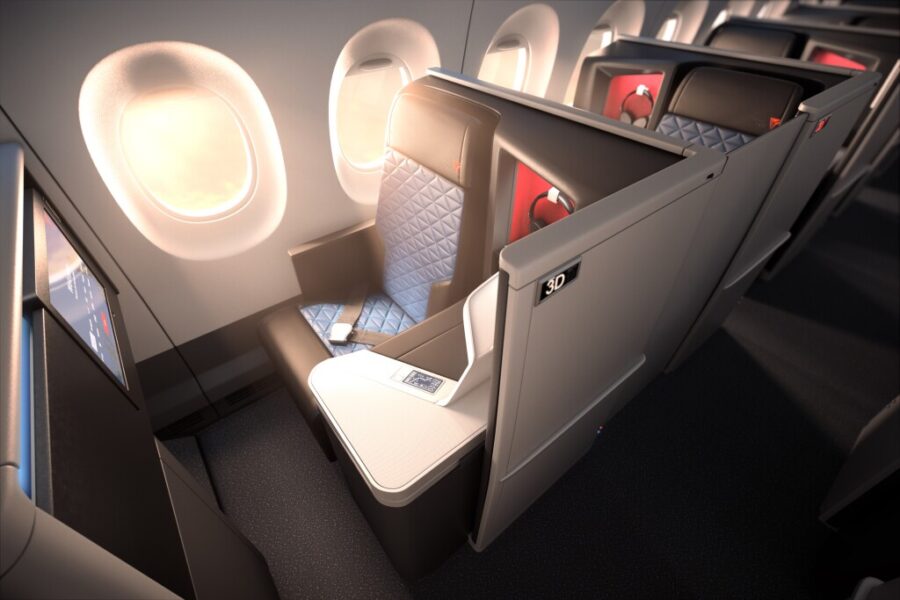Airlines Retrofit Cabins to Meet Surging Premium Seat Demand

Airlines are investing heavily in cabin overhauls to capture booming demand for premium seats among leisure travelers. United Airlines and American Airlines have both reported strong growth in premium cabin revenues and are expanding their premium offerings, even if it means tighter conditions in economy. “Premium leisure demand appears to be more resilient,” says Henry Harteveldt, president of Atmosphere Research. “The people who earn above-average incomes, much higher than above-average incomes and who enjoy traveling are willing to spend extra to have flights that are more comfortable.”
Over the past five years, airlines have seen a surge in leisure travelers buying premium tickets, and the trend shows no sign of slowing. During United’s second-quarter earnings call in July, executives reported a 5.6% increase in premium cabin revenues year over year and confirmed plans to invest in more premium cabin products and capacity in the coming years.
“Demand may not be quite as strong across the board as it once was because of the national economy, because of decrease in travel demand … (but) premium leisure demand appears to be more resilient,” Harteveldt told USA TODAY. “The people who earn above-average incomes, much higher than above-average incomes and who enjoy traveling are willing to spend extra to have flights that are more comfortable.”
To meet that demand, carriers are investing in cabin overhauls focused on adding premium seats. But with limited aircraft cabin space, executives must calculate how to get the right mix of seating onboard. “It’s real estate, the aircraft is real estate,” Ahmed Abdelghany, associate dean for research at Embry-Riddle Aeronautical University’s David B. O’Maley College of Business said. “It has limited space and it’s up to you to put X number of premium seats or Y number of economy seats, but at the end I have to make sure the revenue from the premium seats is the same or higher as for the economy seats in the same space.”
For travelers still looking for economy tickets, the shifting balance can mean a squeeze. Airplane remodeling doesn’t happen overnight, but executives at U.S. airlines have made it clear that doubling down on premium offerings is a key part of their strategy as their aircraft go in for overhauls. American Airlines recently introduced a new business class suite and, like United, said it plans to expand its premium seating in the coming years.
“Airlines are focused on the higher revenue that they’re able to extract from the premium passenger and aircraft cabins are shifting toward the higher premium mix and removing economy class seats to get there,” Seth Miller, editor of paxex.aero, said.
Because cabin designers must work within existing aircraft dimensions, they have limited options for how to add more premium seats. “Depending on the plane, they may be removing lavatories or coat closets or other storage spaces, or reducing galley spaces,” Harteveldt said. “They are doing a lot of things to find ways to free up cabin real estate for seats.”
Sometimes that means taking out economy seating or reducing legroom. “Airlines are either removing seats from the economy class cabin, which arguably is better for passengers that way, or they are squeezing more in economy,” Miller said. “Southwest is a good example of that one where the shift to offer premium seats, even though it’s just economy seating with extra legroom, is creating a situation where those who don’t pay for seating with extra legroom on Southwest are going to have less legroom than what they have on the old configuration Southwest planes.”
Southwest Airlines acknowledged it’s reducing pitch for some economy seats on many planes as it adds extra legroom in other rows. “We didn’t want to remove any seats from the planes so we pulled down an inch of pitch to accommodate the ELR seating and stay at 175 seats,” Chris Perry, a Southwest spokesperson, told USA TODAY, referring to the airline’s Boeing 737-800 and Max 8 planes. He said the airline’s 737-700s will each have six fewer seats after retrofits.
Despite these changes, analysts don’t expect economy seats to disappear. Most carriers will try to optimize cabin space in other ways and add premium seats without dramatically reducing the number of economy passengers they can carry. Still, some economy seats may be more cramped, making it more important for travelers to do their homework before booking.
“I don’t think the value (proposition) for economy has shifted dramatically in recent years. It was maybe a decade or so ago where things changed,” Miller said. “Most of the time, it’s less comfortable than it used to be, but you do still get there. It’s more of a utility now than it used to be, as opposed to an experience.”
To get there as cheaply and comfortably as possible, experts recommend checking seat maps on websites like aerolopa.com, looking for bundled fares that include extras such as checked bags, and booking early with flexible travel dates. “Buy early, make sure you’re including Saturday in your stay,” Abdelghany advised, noting that avoiding peak holiday travel can also help lock in lower fares.
Related News: https://airguide.info/category/magazineonline/airlines/airline-in-flight-services/
Sources: AirGuide Business airguide.info, bing.com, usatoday.com, paxex.aero, Embry-Riddle Aeronautical University
